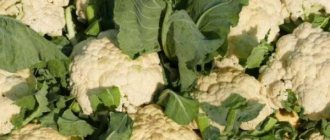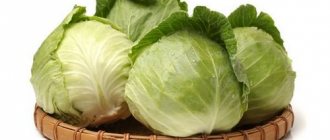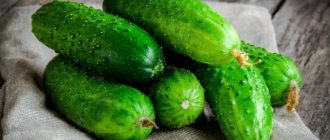How to properly store cabbage in the refrigerator. How long does cabbage last in the refrigerator?
It often happens that a whole head of cabbage is too much to prepare a dish. Most housewives try to save the unused remainder of the product to cook later. The refrigerator is great for this purpose, especially if the head of cabbage is cut or shredded.
When properly stored, the product remains fresh for 2 months, and if you use a freezer, the shelf life increases to 6-12 months.
How to store cabbage in the refrigerator
In order for the vegetable to remain fresh longer, it is important to choose it correctly, reliably protect it from moisture and prepare it before storage. If cabbage is stored at high humidity, it will quickly turn black, the leaves will become withered, and the process of rotting will begin.
When purchasing, pay attention to:
- Later varieties. They retain freshness longer, are easier to process and do not lose their taste during storage.
- Dense and tight heads of cabbage with leaves adjacent to each other.
- Fresh vegetables without defects.
Prepare cabbage for storage:
- Cut off the stalk, remove the top and damaged leaves of the vegetable.
- Wrap the heads of cabbage tightly in cling film in 2-3 layers. The packaging must be airtight and do not allow air spaces between layers. This will prevent moisture from penetrating inside, which will prevent rotting.
- Place the packaged cabbage in the refrigerator. Choose a shelf with a temperature no higher than 2°C.
At low temperatures, store red and white cabbage in whole, cut or shredded form.
Reference. When cut, cabbage retains its properties well, but the cut areas quickly dry out and turn yellow. Refresh the cut before cooking, removing dry areas.
If you plan to use the cabbage within 2-3 days, it is not necessary to store it in a bag. To prepare the product later, wrap the pre-prepared vegetable in a bag or cling film to maintain freshness.
To prevent cabbage from rotting and turning black, it is stored in the vegetable tray provided in most modern refrigerators. If the model does not have a tray, place the forks where you usually store vegetables and set the temperature to the lowest setting.
Also remember to remove wilting leaves from time to time. By performing this simple action, you will extend the shelf life of the vegetable by several days.
Storage options
You can store white cabbage at home fresh, just in heads, providing the plants with certain conditions. This method is available to residents of private houses and city apartments.
Find out how to store other types of cabbage at home in winter: cauliflower, Chinese cabbage, kohlrabi, broccoli.
Cabbage can also be processed. Some recipes allow you to use the vegetable for 2-3 weeks, others – 1-2 years. The most common ways to store cabbage:
- pickling or pickling;
- pickling;
- freezing;
- drying.
How to store cabbage at home is up to you, but first let’s find out which varieties are suitable for this, how and when to harvest.
How to store cabbage. How to properly store cabbage
After harvesting a huge cabbage harvest, the question usually arises: “how to store cabbage in winter.” And this is not surprising. Still, cabbage grown in your own garden is many times better than store-bought cabbage in all respects. At the same time, we are confident that our cabbage does not contain nitrates. This means that such cabbage will be the most useful for the human body. Plus, cabbage from your own garden always tastes better. And it is not discussed. And this is because the cabbage was grown with my own hands.
Varieties and hybrids suitable for winter storage
Only late varieties are suitable for winter storage. At the same time, storage is expected until spring. Further, in the list below, varieties and hybrids are indicated that are ideal for this purpose:
- Amager 611;
- Glory 1305;
- Moskovskaya late 15;
- Wintering 1474;
- Kolobok F1;
- Crewmont F1;
- Mara;
- Snow White;
- Langedijker;
- Turkiz;
There are a huge number of varieties and hybrids suitable for storage in the winter, but you choose based on your preferences and tastes.
How to store cabbage and where
First of all, we need to select and prepare the heads of cabbage that we will store. At the same time, there are certain rules when selecting cabbage that must be followed. Otherwise, nothing will come of this idea. But still, the place where the cabbage will be stored is decisive. This point, in my opinion, is the most important. However, not everyone can afford to have a good cellar. And then, we must understand and imagine different ways. So, we can choose exactly what suits us best.
Preparing cabbage heads for storage
You can store cabbage in different ways, but they always select it for this according to the same rules:
- You need to harvest cabbage in the fall in dry weather, and it is advisable that the temperature be from 0 to +5 degrees. According to scientists, at this temperature, cabbage does not breathe as intensely, and therefore should be stored better. Accordingly, in rainy weather the heads of cabbage need to be dried.
- When cutting, the stalk must be at least 3 cm. You need to cut it with a sharply sharpened knife. And if you plan to store it in a suspended state, then in this case you need to pull out the plant by the roots.
- Do not completely tear off the outer leaves. They protect the fruit from damage and prevent putrefactive fungi from entering the cabbage.
- The head of cabbage should be dense. Loose and unformed fruits are discarded. They are put into processing first.
- There should be no mechanical damage, and the head of cabbage should not be cracked.
- We also set aside sick plants.
- Drying is a mandatory step in preparation for storage.
Optimal storage conditions
Optimal storage conditions are considered to be 0 - +2 C°, with an air humidity of 80 - 90%. With other parameters, the quality of storage decreases accordingly. Therefore, success depends on the conditions you can afford.
Methods for storing cabbage
- Cabbage on weight.
With this method, the cabbage is dug up with roots and hung from the ceiling of the storage room (it is possible without roots, but not recommended). The storage can be anything. The main thing in this matter is compliance with optimal storage conditions. Also, plants should not touch each other. This means that ventilation must be good. - Cabbage in cling film.
In this case, the forks are wrapped in several layers of cling film. At the same time, with the film we, as it were, squeeze out the air and get a vacuum. This method is suitable for any storage facility, as everything is simple and inexpensive. But, you need to periodically inspect the vegetables and, if necessary, change the packaging. In this case, we remove the problem fruits, dry them and wrap them again. - In a paper wrapper.
Dry, prepared cabbage is wrapped in several layers of paper. We inspect it periodically during storage. - In sand . With this method, cabbage is placed in boxes and covered with sand. The process is labor-intensive, and if there is a lot of cabbage, then you won’t get enough sand.
- In clay.
In this method, forks are coated with diluted clay and dried. Then, they put them on shelves, in boxes, racks. This is a very labor-intensive method. Not acceptable for large volumes. - In sand. Here, cabbage placed in a box is sprinkled with sand, and so on, layer by layer. Not very good either.
We just put them in boxes. It's not reliable. Cabbage touching is a minus.
Storage in the apartment
- Fridge . You can't put in too much.
- Pantry. In this case, you can use cabbage wrapped in cling film.
- Glazed loggia. Here, you need to equip a foam cabinet. In extreme frosts, cabbage may freeze. It is advisable to equip some kind of heating.
Good luck to you!
Storing cabbage for the winter at home. How to store cabbage at home in winter?
The best cabbage varieties for long-term storage
The following varieties of cabbage have worked well in winter:
- Vyuga variety – eight months.
- Variety Gift – seven months.
- Variety Dombrovskaya – six months.
- Kharkov winter variety – seven months.
- Belorusskaya variety – seven and a half months.
The following varieties also perform well:
- Variety Stone Head – year.
- Amager variety – nine months.
- Variety Snow White – six months.
- Variety Aros and Atria - ten months.
cabbage storage
Places for long-term storage of cabbage
The cabbage harvest should be stored in the following places during the winter:
Basement or cellar. In these places, it is necessary to put the crops on shelves or hang them from the ceiling. If your harvest turned out to be excellent, then you can stack everything, resembling a pyramid, be sure to stack it with the stalks facing up. Before putting cabbage in these places for storage, then it is necessary to put the premises in order so that it is clean, dry and there are no living creatures there. As soon as it starts to get colder, the required temperature is set in such rooms, which helps to avoid losses. In such premises, cabbage is stored for eight months.
Basement
Storage room. Cabbage can be stored in such a room for some time. This method is most suitable for apartments rather than private houses. In a special cool place, cabbage can be preserved longer and better, but the main thing is to pack it in cling film or parchment paper. The forks must not be spread out tightly enough to allow air to circulate. It is in these conditions that cabbage is stored for six months.
pantry
Fridge. Such a crop must be placed in a special freshness zone, where it will be possible to create the necessary temperature for preservation. If you don’t have such a place, then the forks should be put in a section of the refrigerator in which the temperature is quite minimal. Cabbage heads must be packed in film or parchment. In this option, your harvest can be stored for about a month.
Fridge
Balcony. If this room is insulated, then it is necessary to maintain the same temperature all the time; you also need to wrap the crop in paper or film. As soon as it starts to get colder, then the cabbage needs to be put in a closet or wrapped in insulation. The shelf life of cabbage in this case will be five months.
Balcony
Depression in the ground. This storage location is perfect for large cabbage. It is worth understanding that cabbage heads can get damp in such a place and can rot, and when frosts begin, it becomes problematic to get the harvest from there. In this case, you need to dig a trench on a hill, the depth will be half a meter and the width a little more, you need to put straw on the bottom, then lay out cabbage, and then put more straw on top of it, and at the very end, cover everything with a shield of wood. Then be sure to compact the soil on top, its thickness will be approximately 200cm.
Trench
Optimal conditions
The quality of storing cabbage at home depends on the indoor climate. It is imperative to maintain a stable temperature, which is no more than two degrees Celsius, and air humidity should not exceed 95%. There must be ventilation in the room. If you follow these parameters, your harvest can last for eight months.
Harvest storage methods
There are quite a few different ways that help store cabbage harvest, let's look at the different options:
- Box. This option is quite simple, suitable for use in a basement or cellar. In this method, the vegetables are laid evenly without touching each other. Such containers must be installed on small pallets.
- Shelves. Racks with shelves are installed near the wall. Cabbage is laid out directly on them, which is dried in advance, peeled, and then covered with leaves on top. Be sure to lay it so that there are gaps of about two centimeters between the heads of cabbage.
- On paper. In this option, only dried cabbage is stored. You can use newspapers, only clean paper is needed for the first layer. The paper prevents the cabbage from touching, thereby allowing it to be stored for a long time and keep out the cold. The packed cabbage is then placed in boxes or bags.
- Film. This option is the most effective. The prepared cabbage is packaged in cling film and then placed on racks or in a special container. It is imperative to check vegetables during storage so that they do not spoil.
Step by step instructions
Storing cabbage in a garage pit:
- Harvest cabbage.
- Trim the stems, leaving only the heads.
- Dry if necessary and treat to remove unsuitable leaves.
- Wrap each head of cabbage in cling film.
- Place it in the garage pit.
Storing cabbage in a caisson:
- Harvest cabbage.
- Trim the stems, leaving only the heads.
- Peel off the topmost layer of leaves.
- Place in wooden boxes.
- Sprinkle with sand if possible.
- Place the boxes on the floor of the caisson.
To store cabbage in cling film you need:
- Dry the collected heads of cabbage if necessary.
- Peel the top one layer of leaves.
- Wrap each head of cabbage with several layers of film.
- Place in any convenient container or on shelves.
Storing cabbage with roots:
- Dig up the cabbage by the roots.
- Tie a rope to each head of cabbage by the leg.
- Hang the heads of cabbage from the ceiling of the cellar using it.
How to hang cabbage with roots - photo:
Storing cabbage heads:
- Harvest cabbage.
- Remove the stems, leaving only the heads.
- Remove the top layer of leaves.
- Place the heads of cabbage in boxes, on shelves or in a pyramid, and wrap in film if desired.
You will learn how to store cabbage in the cellar using a vacuum cleaner by watching the video:
How to store carrots in the refrigerator. How to store carrots in a plastic bag all winter
Carrots have firmly entered the daily diet of people living in different countries and continents. This root vegetable is not only tasty, but very healthy. It is used for preparing both first and second courses, as well as for creating desserts and preserves. The vegetable has about 60 species, and its cultivation does not present any particular difficulties, which cannot be said about storing carrots. Rotting or drying of the vegetable with loss of taste and beneficial qualities, alas, often happens with this root vegetable. How to avoid this and whether it is possible to store carrots in plastic bags - let's figure it out together.
Optimal storage conditions for this root vegetable are achieved at temperatures from 0 to + 3 ° C and a relative room humidity of approximately 90%. In addition, the place where carrots are stored should be well ventilated. A basement or cellar will be an excellent storage for a capricious vegetable, the maximum shelf life of which can be up to 12 months.
One of the most convenient, easy-to-install and hygienic ways to store carrots is in the ubiquitous plastic bags. This attribute, without which it is impossible to imagine the life of modern civilization, is widely available and has a low cost. However, storing carrots in plastic bags has its drawbacks. Firstly, this is not the longest possible shelf life for a vegetable. Secondly, frequently monitor the condition of the carrots, dry them from condensation, and replace wet bags with new ones. These measures will help preserve root crops for up to 4 months.
Before storing carrots for storage, they must be dried for 10-14 days, the tops must be cut off so that they do not absorb nutrients, and sorted. Only whole, undamaged, dry and clean vegetables are selected for storage. It is very important to ensure timely harvesting. If carrots are kept in the soil until frost, gray rot may appear on them. And if you harvest the crop ahead of time, when the earth has not yet had time to cool, and send the carrots for storage in a cold cellar, then this can also negatively affect the duration of storage of root crops. Many gardeners focus on the condition of the lower carrot leaves: as soon as they turn yellow, it’s time to dig up the crop.
When storing carrots in the cellar, plastic bags of any size are suitable. If there are a lot of root vegetables, then you can use plastic bags that can hold up to 20 kg of vegetables. It is imperative to make a sufficient number of holes on the bags to allow condensation to evaporate, especially at the bottom of the bags, and place them on a stand. There is no need to tie the bags tightly.
You can store carrots in plastic bags not in the cellar, but in the refrigerator, both whole and in chopped form. The latter is stored in the freezer, which significantly increases the shelf life of vegetables. By the way, it is not recommended to store carrots in vacuum bags either in the cellar or in the refrigerator. Root vegetables emit carbon dioxide during storage, which, accumulating in a vacuum, will lead to rapid spoilage of vegetables.
Practical freezing
Freezing vegetables is a labor-intensive technology for preserving food. In this way, you can prepare greens, some vegetables and fruits for the winter. But is it possible to freeze cabbage in the freezer? Yes, as semi-finished products for preparing first and second courses.
The easiest way to prepare sliced cabbage is:
- Take fresh, tight heads of cabbage, remove the outer leaves, and cut out the stalk.
- Rinse the head under running water and let it dry.
- Cut the vegetable into small strips.
- Place the prepared cuts in plastic containers or plastic bags.
- Place the workpiece in the freezer compartment of the refrigerator.
Cabbage can be stored in the freezer longer than in the vegetable compartment - from 6 months. up to 1 year. You can use it immediately; there is no need to wait until the product thaws.
Frozen cabbage is not suitable for salads, as it loses its appearance and crunch. But for preparing hot dishes - just right
You can also freeze cabbage individual leaves. Such preparations are suitable for preparing cabbage rolls. To do this, use summer varieties or loose, loose heads of late ripening.
- For whole cabbage, remove the top leaves and the stem.
- Rinse and dry the vegetable.
- Carefully separate the heads of cabbage into individual leaves.
- Place the workpiece into bags in portions.
- Place the cabbage leaves in the freezer.
Frozen cabbage must thaw before cooking. To do this, place it on the bottom shelf of the refrigerator. When it softens, the dish can be cooked.
A big plus in favor of freezing cabbage for cabbage rolls is that the vegetable does not need to be boiled first. The leaves are quite soft after defrosting.
Note to the hostess
Not all varieties behave “persistently”. Some spread out after defrosting, and you won’t be able to roll the cabbage rolls. If you don’t know how cabbage will behave, then immediately roll up the cabbage rolls and freeze them.
How to tell if cabbage has gone bad. What to look for when choosing cabbage?
To understand how to choose the right cabbage, you need to remember the basic rules for purchasing this vegetable.
- Choose heads of cabbage with fresh, unpicked leaves. They should fit tightly to each other and not create the effect of an open fruit.
- Avoid fruits with brown or black areas, even if they are small. This indicates damage by fungi or putrefactive bacteria.
- Inspect the leaves for insect damage, which will show up as grooves or other blemishes on the leaves. Their large number suggests that it is better not to buy such cabbage.
- The head of cabbage must be strong. If when squeezing there is a feeling of softness and airiness, it is better not to choose it, as this indicates staleness or damage to the fruit.
- The leaves should be a rich green color. If they are dull, this does not speak in favor of such heads of cabbage.
- If cabbage has yellow or wilted leaves, it means it is lacking in freshness.
- The heads of cabbage should look clean and smooth, without obvious traces of chemical treatment or signs of frostbite.
- Significant mechanical damage will lead to a rapid loss of vitamin C, so fruits with them should be avoided when choosing.
- If stored improperly, cabbage begins to sprout, which can be seen with the naked eye. Therefore, not only choose smooth, strong heads of cabbage, but also place them in the refrigerator at a temperature of 0 to 4 degrees if you do not plan to use them immediately after purchase.
- The presence of a large number of dry layers in the heads of cabbage (parchment of the inner leaves) is also a defect, due to which the fruits should not be purchased.
Shelf life of cabbage in the refrigerator. How long does cooked food last in the refrigerator?
Sanitary standards for the shelf life of perishable foods in the refrigerator, at a temperature of +2 - +6 degrees Celsius, approved by the USSR Ministry of Health in 1986 and still used by regulatory authorities in post-Soviet countries, can hardly be considered guidelines for home use. Their main goal is to prevent food from becoming infected even in the most unfavorable conditions. Such, for example, as heat and a high level of microbial contamination outside the refrigeration chamber at the time of preparation of the semi-finished product, or sharply reduced immunity in the consumer.
It is interesting to note that domestic standards are more stringent than in many other countries: for example, rules for army canteens in the United States allow most types of portioned food to be stored for 24 hours.
In addition, these standards do not require the use of special storage devices: such as tightly packing hot dishes in cling film, foil, or placing them in vacuum containers. Meanwhile, such measures can really extend the life of the product.
Most consumers are accustomed to determining the suitability of a product for consumption based on its appearance, smell and taste. And this method has its own logic: rotting, fermentation, fat oxidation and microbiological spoilage, possible in a refrigerator, usually lead to a change in the organoleptic properties of food. It makes sense to play it safe when it comes to foods high in protein and moisture - raw eggs in homemade sauces, homemade meat and fish salads.
It is worth considering that mono-component products deteriorate more slowly (for example, boiled rice, beans, pasta without dressing). Boiled root vegetables with their skins can be stored in the refrigerator for up to a week if not peeled. Among multi-component dishes, those that use vinegar or contain other organic acids can withstand storage for 2-4 days - for example, cooked fish or raw vegetables in marinade, soups with sauerkraut. The most favorable storage place for prepared dishes in the refrigerator is the top shelf or the zero “freshness zone” in advanced models.
The data on expiration dates published below, determined by SanPiN 42-123-4117-86, can be taken into account rather as food for thought. That is, focus on the ratios of indicators that indicate the most perishable products, and not take a specific number of hours as a norm.
So, according to SanPiN 42-123-4117-86, finished products can be stored in the refrigerator at a temperature of +2 - +6 degrees Celsius for the following periods (in hours):
Boiled meat, in large pieces – 24; fried meat (large pieces) – 48; stuffed stewed meat – 24; boiled meat offal
(tongue, udder, heart, kidneys, brains) – 18; fried liver – 24; fried minced meat products
(cutlets, steaks, schnitzels) – 12; meat jellies and jellied meat – 12; baked duck and chicken carcasses – 48; fried poultry and rabbit meat – 48; boiled poultry carcasses – 24; boiled poultry, chopped into portions, in jelly – 24; poultry cutlets – 12; boiled eggs – 24; fried fish of all types – 36; baked fish of all types – 48; boiled fish of all types – 24; stuffed fish – 24; boiled crayfish and shrimp – 12; squid products – 24; jellied fish – 24; cabbage, carrot, vegetable, potato casserole with meat – 18 fresh chopped white cabbage, blanched – 12 onions, sautéed carrots – 48 sauerkraut salad – 24; boiled peeled vegetables: carrots – 24; beets – 24; potatoes – 18; salads (meat, capital, fish) undressed – 12; cakes and pastries: or with fruit decoration – 72; including “Potato” cake – 36; with custard, with whipped cream – 6.
It is worth considering that mono-component products deteriorate more slowly (for example, boiled rice, beans, pasta without dressing). Boiled root vegetables with their skins can be stored in the refrigerator for up to a week if not peeled. Among multi-component dishes, those that use vinegar or contain other organic acids can withstand storage for 2-4 days - for example, cooked fish or raw vegetables in marinade, soups with sauerkraut. The most favorable storage place for prepared dishes in the refrigerator is the top shelf or the zero “freshness zone” in advanced models.











